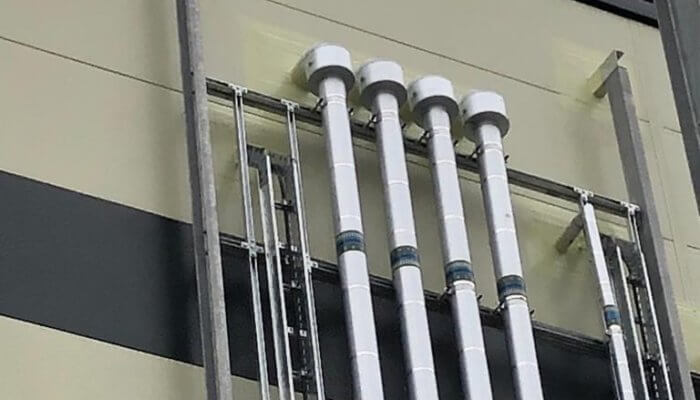In today’s highly connected and electrified world, cable trays play a hugely important role in how we power our buildings and share information, so protecting them with effective weatherproofing is key to mitigating risk and keeping operations running smoothly.
What is a cable tray?
From data centres to factories, shopping centres to office buildings, cable trays are everywhere. Often, they go unnoticed, but as soon as you start looking for them, cable trays are easy to spot on the walls and roofs of buildings. They are also likely to be hidden from view, weaving their ways through interior walls and roof spaces.
Cable trays are support systems, creating a rigid route for cables and wires to travel from one point to another. As an alternative to conduits, cable trays are preferable as their open nature makes it easier to change wiring or install new cables, as they can simply be laid in place, rather than fed through conduit pipes. However, this can also pose a challenge for weatherproofing.
Weatherproofing cable trays
The point where cable trays enter a building can be vulnerable to wind and rainwater ingress, so careful planning and effective weatherproofing of the building penetration are critical.
The effective weatherproofing of cable trays helps to keep weather out, preventing damage to the building envelope, avoiding thermal breaks, maintaining the indoor environment and helping to keep the various cables and wires protected. It can also help to keep out birds, rodents and insects. Fire safety and the preservation of fire walls are also important considerations.
The best method for weatherproofing cable trays will depend on whether the cables are entering the building through a vertical wall penetration or a roof penetration. Other factors such as how the building is constructed, exposure, and how many cables there are. Aesthetics may also play a role in determining the best solution.
In vertical wall penetrations, weatherproofing cable trays is often carried out using a weatherstop sealing system. From the outside, this looks like ductwork or a series of boxes attached to the side of the building. These create a sealed entrance for the cables to make their way inside, and must be carefully weatherproofed. In some cases, sealants such as GRP weathering systems may be used, enabling a cable tray to penetrate a wall without ductwork or other protective structures.
For roof penetrations, service risers are used to ensure a weatherproof seal around cable trays as they enter the building. As well as being waterproof and windproof, these must also be structurally sound. Upstands and other supporting structures may be used, along with products such as GRP sealants, to create a suitable solution.
Cable tray weatherproofing from Jones Weatherproofing
With so much to think about when weatherproofing cable trays, it’s easy to see the benefits of getting expert help when dealing with cable trays and building penetrations.
With more than 45 years of experience, Jones Weatherproofing have extensive experience in weatherproofing roof and wall penetrations. We offer a complete range of services from design and installation through to maintenance, and have worked on a wide range of projects including data centres, offices, shopping centres, airports and factories.
Our GRP weathering system comprises a fibre-reinforced, cold-applied liquid that can be used with any type of cladding and single-ply membrane roofs. The system is versatile and reliable; it can be adjusted to suit penetrations of any size or shape, and it can also be tinted to match the rest of the building design.
To find out more, visit our dedicated page about data centre weatherproofing. You can also contact us to discuss your project in more detail – or call 01922 712111.

